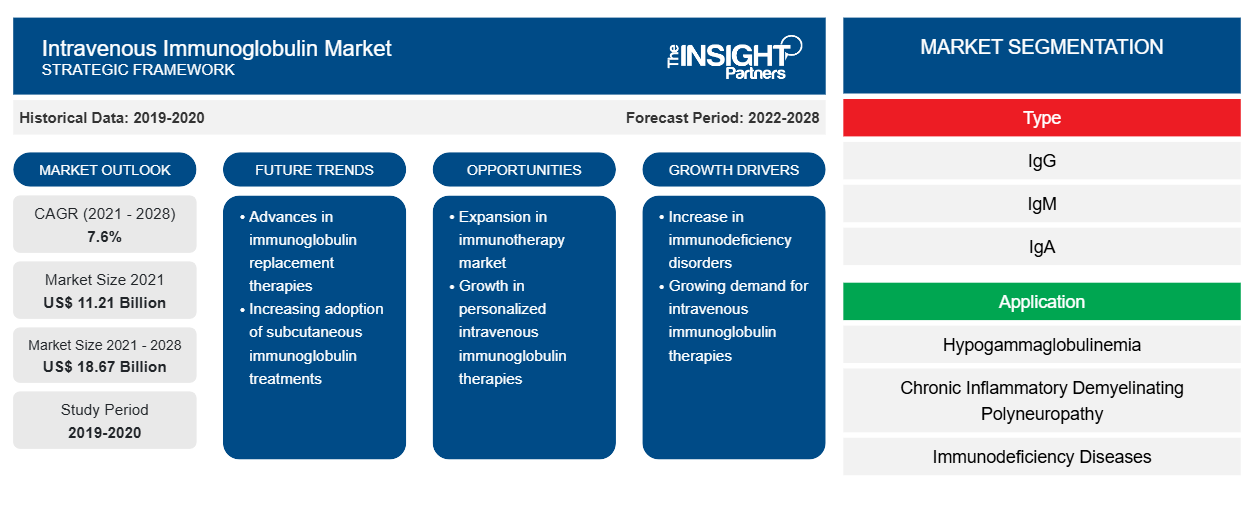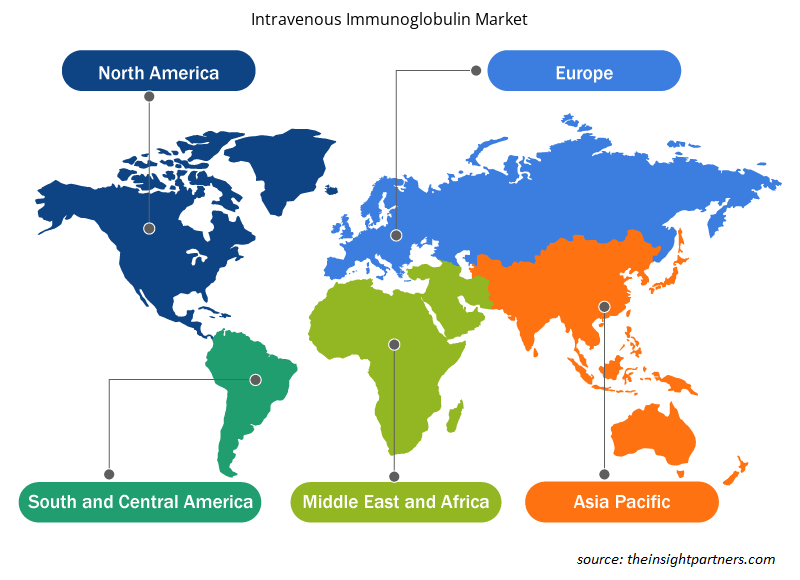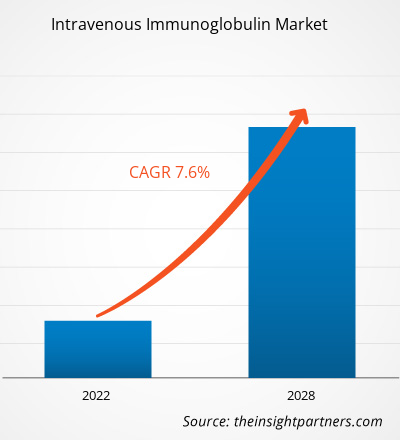The intravenous immunoglobulin market was valued at US$ 11,206.54 million in 2021 and is likely to reach to a value of US$ 18,672.55 million by 2028; it is estimated to grow at a CAGR of 7.6% from 2022 to 2028.
Immunoglobulins are the antibodies produced naturally by the body’s immune system, which help fight infection and disease. The deficiency of immunoglobulin requires the external administration of immunoglobulin and is known as immunoglobulin replacement therapy (IgRT). IgRT can be given intravenously and subcutaneously. Intravenous immunoglobulin (IVIg) and subcutaneous immunoglobulin (SCIg) are selected based on the indication and severity. IVIg is manufactured from human plasma. It contains antibodies and is used to treat a growing number of immunologic, hematologic, and neurologic illnesses.
The intravenous immunoglobulin market is segmented into type, application, distribution channel, end user, and geography. By geography, the market is broadly segmented into North America, Europe, Asia Pacific, the Middle East & Africa, and South & Central America. This report offers insights and in-depth analysis of the market, emphasizing parameters, such as market trends, market dynamics, and the competitive analysis of the globally leading market players.
Customize This Report To Suit Your Requirement
You will get customization on any report - free of charge - including parts of this report, or country-level analysis, Excel Data pack, as well as avail great offers and discounts for start-ups & universities
Intravenous Immunoglobulin Market: Strategic Insights

- Get Top Key Market Trends of this report.This FREE sample will include data analysis, ranging from market trends to estimates and forecasts.
Customize This Report To Suit Your Requirement
You will get customization on any report - free of charge - including parts of this report, or country-level analysis, Excel Data pack, as well as avail great offers and discounts for start-ups & universities
Intravenous Immunoglobulin Market: Strategic Insights

- Get Top Key Market Trends of this report.This FREE sample will include data analysis, ranging from market trends to estimates and forecasts.
Market Insights
Rising prevalence of immunodeficiency diseases and increasing geriatric population is driving the intravenous immunoglobulin market.
According to the National Institute of Allergy and Infectious Diseases (NIAID), over 200 different types of primary immune deficiency diseases (PIDDs) affect about 500,000 people in the US. The rare genetic diseases can be chronic, weak, and expensive. Immune Thrombocytopenia (ITP) is an autoimmune bleeding disorder characterized by abnormally low levels of platelets; a situation referred to as thrombocytopenia. According to the Rare Diseases Organization, around 200,000 ITP cases are recorded worldwide annually. Further, according to the United Nations Population Division, World Population Prospects 2019, Asian and European countries have some of the world’s oldest populations aged 65 and over. Japan is at the top with 28%, followed by Italy at 23%. Further, Finland, Portugal, and Greece are among the top five countries with an aged population under 22%. Many of the patients treated with IVIG are above the age of 60 years. With aging, the ability to produce T-cells to fight diseases gets significantly reduced. Thus, an older person’s body is easily prone to several infections and diseases, which increases the demand for immune therapies that involve the use of IVIg. Thus, the rise in immunodeficiency diseases and increasing geriatric population across the globe is bolstering the intravenous immunoglobulin market.
Type-Based Insights
Based on the type, the intravenous immunoglobulin market is segmented into IgG, IgM, IgA, IgE, and IgD. The IgG type immunoglobulin segment held the largest market share in 2021. However, the handheld segment is anticipated to register the highest CAGR during the forecast period owing to its wide application of IgG in treating several categories of disorders.
Application-Based Insights
Based on application, the intravenous immunoglobulin market is segmented into hypogammaglobulinemia, chronic inflammatory demyelinating polyneuropathy, immunodeficiency diseases, myasthenia gravis, multifocal motor neuropathy, idiopathic thrombocytopenic purpura, inflammatory myopathies, specific antibody deficiency, Guillain-Barre syndrome, and others. In 2021, the immunodeficiency diseases segment held the market's largest share. Moreover, the same segment is expected to witness growth in its demand at the fastest CAGR from 2022 to 2028 due to the rising prevalence of immunodeficiency diseases and increasing FDA approvals for IVIg products to treat immunodeficiency.
Distribution Channel-Based Insights
Based on distribution channel, the intravenous immunoglobulin market is segmented into hospital pharmacy, retail pharmacy, and others. In 2021, the hospital pharmacy segment held the largest share of the market. Further, the retail pharmacy segment is expected to witness growth in its demand at the fastest CAGR from 2022 to 2028, owing to the expansions of retail pharmacies and the shift of consumer behavior towards organized retail pharmacies that offer high-quality drugs and medicines.
End User-Based Insights
Based on end user, the intravenous immunoglobulin market is segmented into hospitals, specialty clinics, and others. In 2021, the hospitals segment held the largest share of the market. Further, the specialty clinics segment is expected to witness growth in demand at the fastest CAGR from 2022 to 2028, owing to the advances in specialty clinics for offering quick and accurate IgRT to patients.
Organic developments such as product approvals are highly adopted strategies by the global intravenous immunoglobulin market players. A few of the recent key market developments are listed below:
- In March 2022, ADMA Biologics, Inc. announced the United States Food and Drug Administration’s (FDA) approval to extend the expiration dating from 24 to 36 months for both its ASCENIV and BIVIGAM immune globulin (“IG”) drug product stored at 2-8°C. The expiration date extension applies to all existing ASCENIV and BIVIGAM lots currently in the commercial supply chain as well as to future production of ASCENIV and BIVIGAM in all vial sizes, production scales as well as internal and external fill-finished drug product.
- In June 2021, Octapharma announced that octagam 10%, a human plasma-derived intravenous immunoglobulin (IVIg), has recently been granted approval in the European Union (EU) as an immunomodulatory therapy for adults with dermatomyositis. Following the EU approval, octagam 10% received national approval in Germany on May 11, 2021, with approval in other European member states expected soon.
- In April 2021, ADMA Biologics, Inc. announced that the U.S. Food and Drug Administration (“FDA”) approved the Company’s expanded manufacturing process, enabling fractionation and purification of a 4,400-liter plasma pool for the manufacture of Intravenous Immune Globulin (“IVIG”).
- In February 2020, CSL Behring announced that the U.S. Food and Drug Administration (FDA) granted Privigen (Immune Globulin Intravenous (Human), 10% Liquid) orphan-drug designation as an investigational therapy in the treatment of Systemic Sclerosis (SSc).
Such developments by market players are driving the intravenous immunoglobulin market.
Intravenous Immunoglobulin Market Regional Insights
The regional trends and factors influencing the Intravenous Immunoglobulin Market throughout the forecast period have been thoroughly explained by the analysts at Insight Partners. This section also discusses Intravenous Immunoglobulin Market segments and geography across North America, Europe, Asia Pacific, Middle East and Africa, and South and Central America.

- Get the Regional Specific Data for Intravenous Immunoglobulin Market
Intravenous Immunoglobulin Market Report Scope
| Report Attribute | Details |
|---|---|
| Market size in 2021 | US$ 11.21 Billion |
| Market Size by 2028 | US$ 18.67 Billion |
| Global CAGR (2021 - 2028) | 7.6% |
| Historical Data | 2019-2020 |
| Forecast period | 2022-2028 |
| Segments Covered |
By Type
|
| Regions and Countries Covered | North America
|
| Market leaders and key company profiles |
Intravenous Immunoglobulin Market Players Density: Understanding Its Impact on Business Dynamics
The Intravenous Immunoglobulin Market market is growing rapidly, driven by increasing end-user demand due to factors such as evolving consumer preferences, technological advancements, and greater awareness of the product's benefits. As demand rises, businesses are expanding their offerings, innovating to meet consumer needs, and capitalizing on emerging trends, which further fuels market growth.
Market players density refers to the distribution of firms or companies operating within a particular market or industry. It indicates how many competitors (market players) are present in a given market space relative to its size or total market value.
Major Companies operating in the Intravenous Immunoglobulin Market are:
- Takeda Pharmaceutical Company Limited
- Grifols, S.A.
- Pfizer Inc.
- ADMA Biologics Inc.
- Bio Products Laboratory Ltd.
Disclaimer: The companies listed above are not ranked in any particular order.

- Get the Intravenous Immunoglobulin Market top key players overview
Intravenous Immunoglobulin – Market Segmentation
The global intravenous immunoglobulin market is segmented into type, application, distribution channel, end user, and geography. Based on type, the market is segmented into IgG, IgM, IgA, IgE, and IgD). By Application, the market is segmented into hypogammaglobulinemia, chronic inflammatory demyelinating polyneuropathy, immunodeficiency diseases, myasthenia gravis, multifocal motor neuropathy, idiopathic thrombocytopenic purpura, inflammatory myopathies, specific antibody deficiency, Guillain-Barre syndrome, and others. Based on distribution channel, the market is segmented into hospital pharmacy, retail pharmacy, and others. By End User, the market is segmented into hospitals, specialty clinics, and others. By geography, the market is segmented into North America, Europe, Asia Pacific, Middle East & Africa, and South & Central America.
Company Profiles
- Takeda Pharmaceutical Company Limited
- Grifols, S.A.
- Pfizer Inc.
- ADMA Biologics Inc.
- Bio Products Laboratory Ltd.
- Shanghai RAAS
- Octapharma AG
- Kedrion S.p.A
- CSL Behring (CSL Limited)
- Prothya Biosolutions B.V.
Frequently Asked Questions
Who are the key players in the intravenous immunoglobulin market?
The intravenous immunoglobulin market majorly consists of the players such as Takeda Pharmaceutical Company Limited; Grifols, S.A.; Pfizer Inc.; ADMA Biologics Inc.; Bio Products Laboratory Ltd.; Shanghai RAAS; Octapharma AG; Kedrion S.p.A; CSL Behring (CSL Limited); and Prothya Biosolutions B.V.
Which region is fastest growing?
Based on geography, the APAC region is accounted for highest CAGR in intravenous immunoglobulin market during the forecast period.
Which segment led the intravenous immunoglobulin market?
The IgG segment under type segment, held the largest share in 2021.
What are intravenous immunoglobulins?
Immunoglobulins are the antibodies produced naturally by the body’s immune system, which help fight infection and disease. The deficiency of immunoglobulin requires the external administration of immunoglobulin and known as immunoglobulin replacement therapy (IgRT). IgRT can be given intravenously and subcutaneously. Intravenous immunoglobulin (IVIg) and subcutaneous immunoglobulin (SCIg) are selected based on the indication and severity. IVIg is manufactured from human plasma. It contains antibodies and is used in the treatment of a growing number of immunologic, hematologic and neurologic illnesses.
- Historical Analysis (2 Years), Base Year, Forecast (7 Years) with CAGR
- PEST and SWOT Analysis
- Market Size Value / Volume - Global, Regional, Country
- Industry and Competitive Landscape
- Excel Dataset
Testimonials
I wish to appreciate your support and the professionalism you displayed in the course of attending to my request for information regarding to infectious disease IVD market in Nigeria. I appreciate your patience, your guidance, and the fact that you were willing to offer a discount, which eventually made it possible for us to close a deal. I look forward to engaging The Insight Partners in the future, all thanks to the impression you have created in me as a result of this first encounter.
DR CHIJIOKE ONYIA, MANAGING DIRECTOR, PineCrest Healthcare Ltd.The Insight Partners delivered insightful, well-structured market research with strong domain expertise. Their team was professional and responsive throughout. The user-friendly website made accessing industry reports seamless. We highly recommend them for reliable, high-quality research services
Yukihiko Adachi CEO, Deep Blue, LLC.Reason to Buy
- Informed Decision-Making
- Understanding Market Dynamics
- Competitive Analysis
- Customer Insights
- Market Forecasts
- Risk Mitigation
- Strategic Planning
- Investment Justification
- Identifying Emerging Markets
- Enhancing Marketing Strategies
- Boosting Operational Efficiency
- Tracking Industry Innovations
- Aligning with Regulatory Trends
Yes! We provide a free sample of the report, which includes Report Scope (Table of Contents), report structure, and selected insights to help you assess the value of the full report. Please click on the "Download Sample" button or contact us to receive your copy.
Absolutely — analyst assistance is part of the package. You can connect with our analyst post-purchase to clarify report insights, methodology or discuss how the findings apply to your business needs.
Once your order is successfully placed, you will receive a confirmation email along with your invoice.
• For published reports: You’ll receive access to the report within 4–6 working hours via a secured email sent to your email.
• For upcoming reports: Your order will be recorded as a pre-booking. Our team will share the estimated release date and keep you informed of any updates. As soon as the report is published, it will be delivered to your registered email.
We offer customization options to align the report with your specific objectives. Whether you need deeper insights into a particular region, industry segment, competitor analysis, or data cut, our research team can tailor the report accordingly. Please share your requirements with us, and we’ll be happy to provide a customized proposal or scope.
The report is available in either PDF format or as an Excel dataset, depending on the license you choose.
The PDF version provides the full analysis and visuals in a ready-to-read format. The Excel dataset includes all underlying data tables for easy manipulation and further analysis.
Please review the license options at checkout or contact us to confirm which formats are included with your purchase.
Our payment process is fully secure and PCI-DSS compliant.
We use trusted and encrypted payment gateways to ensure that all transactions are protected with industry-standard SSL encryption. Your payment details are never stored on our servers and are handled securely by certified third-party processors.
You can make your purchase with confidence, knowing your personal and financial information is safe with us.
Yes, we do offer special pricing for bulk purchases.
If you're interested in purchasing multiple reports, we’re happy to provide a customized bundle offer or volume-based discount tailored to your needs. Please contact our sales team with the list of reports you’re considering, and we’ll share a personalized quote.
Yes, absolutely.
Our team is available to help you make an informed decision. Whether you have questions about the report’s scope, methodology, customization options, or which license suits you best, we’re here to assist. Please reach out to us at sales@theinsightpartners.com, and one of our representatives will get in touch promptly.
Yes, a billing invoice will be automatically generated and sent to your registered email upon successful completion of your purchase.
If you need the invoice in a specific format or require additional details (such as company name, GST, or VAT information), feel free to contact us, and we’ll be happy to assist.
Yes, certainly.
If you encounter any difficulties accessing or receiving your report, our support team is ready to assist you. Simply reach out to us via email or live chat with your order information, and we’ll ensure the issue is resolved quickly so you can access your report without interruption.















The List of Companies - Intravenous Immunoglobulin Market
- Takeda Pharmaceutical Company Limited
- Grifols, S.A.
- Pfizer Inc.
- ADMA Biologics Inc.
- Bio Products Laboratory Ltd.
- Shanghai RAAS
- Octapharma AG
- Kedrion S.p.A
- CSL Behring (CSL Limited)
- Prothya Biosolutions B.V.






 Get Free Sample For
Get Free Sample For